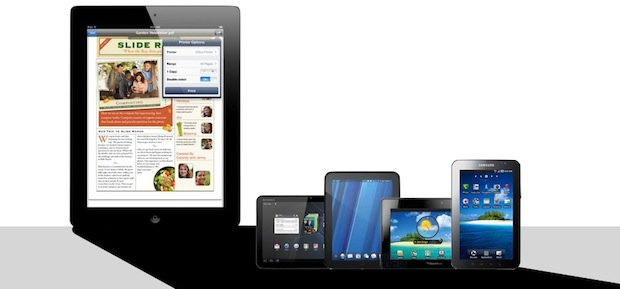Deep Inside the Frustrating World of Second-Tier Tablets: Flaws, Fights, Fails
BY Kit Eaton
As Apple reveals its next-gen iPad 2 (with the first edition still acting as the Moses of Tabletland) the high-profile makers of competing devices are squabbling, mis-stepping, or generally not delivering.
HP Says RIM is cloning its efforts
After its acquisition of ailing smartphone-maker Palm, the expectations were high that HP--with its long history of delivering quality computing products--could manipulate Palm's expertise into some sort of wondrous tablet. It's since revealed plans for the TouchPad which, though it's yet to arrive, has indeed stirred a deal of excitement. It does have its flaws--it's essentially a clone of Apple's iPad 1, up-specced to slightly beat Apple's initial tablet offering, with just one camera and what's rumored to be poorer battery life.
Now HP's in the news again, this time accusing RIM of outright copying in its own PlayBook tablet PC--which is also yet to arrive on sale. HP's Jon Oakes noted "uncanny similarities" between RIM's QNX-inspired UI for its tablet and HP's own updated webOS UI, before noting HP will energize itself and move on in a "fast innovation cycle" leaving RIM following "by about a year." Stern words, and all the more surprising for their public nature. RIM's rebuttal seems limited to mentioning parallel evolution and convergence of design--"cars over time end up looking a lot alike" because you optimize their shape for current tech and wind resistance.
RIM picks terrible date to launch the PlayBook
A leaked bit of info to website BGR.com suggests RIM will be taking its updated tablet OS to gold master status on March 31st, and that the Playbook will actually hit retailers shelves on April 10th. Quite apart from the fact that the first thing buyers may have to do is update their OS the moment they turn the Playbook on (to accommodate tweaks RIM makes in the interim 10 days) the timing is shocking. The iPad 2 was revealed yesterday, and will hit stores imminently--March 11th in the US and in 26 nations on March 25th. We can expect millions to sell almost instantly, and the device will vacuum-up all the limelight that RIM was going to shine on its tablet.
Motorola prices the Xoom into the stratosphere, LG follows
The Wall Street Journal was moved to comment on several articles about the suspected build cost of the Motorola Xoom tablet, which rocks in at over $30 more expensive than a similarly-specced Apple iPad 1. That 30 bucks is a trivial figure, you may think, but multiplied out over millions of units of sales it represents significant profit margin erosion. Motorola seems to be recovering the loss by pricing the Xoom pretty high--it's $600 on contract, $800 off in the U.S., leaked info puts the UK's 3G version at £600 ($980, though this does include tax) and suggestions from Germany hint at a €700 bracket ($970). Remember the iPad goes from $499 without 3G to $829 with 64GB of RAM and 3G.
Some of the "extra" cost in the Xoom comes from the inclusion of cameras ($14) and a screen that may cost $5 more than Apple's unit does. But this didn't deter Apple from including similar facilities in its iPad 2, and pricing the units at the same levels as the iPad 1's. Apple is probably taking a small hit on profits here, hoping to recover them with margins on accessories like the sleek new magnetic iPad 2 case.
But if that's the case, couldn't Motorola have pulled off a similar trick with the Xoom in order to establish some solid sales and stamp a good footprint into the tablet market? After all, the Xoom itself has earned a lot of buzz and compliments from the tech media, and technologically speaking, it looks to be one of the strongest challengers to the iPad. Meanwhile LG's much-vaunted Optimus Pad, an 8.9-inch Android Honeycomb unit with dual rear cams for 3G seems due to arrive in Europe for prices well over an equivalent of $1,000--LG is suffering the same issues as Motorola.
Samsung Galaxy Tab not meeting sales expectations
Samsung's Galaxy Tab, a 7-inch Android tablet was the first serious challenger to the iPad, arriving much later in 2010, but at first gathering some (seemingly) impressive sales.
Earlier this year Samsung was hit with claims the Galaxy Tab had a 16% return rate (up from pre-holiday figures of 13% in 2010), compared to a 2% return rate for the iPad--as quoted by Verizon, selling the Wi-Fi only version at the time. Samsung has since announced these figures aren't correct, quoting its return rate is also around 2%. But the firm also backtracked on earlier claims it had sold around 2 million units and admitted its sales to consumers had been "quite small," which suggested the Tab hadn't captured consumer imagination as much as the hype suggested it had.
Meanwhile Samsung's Galaxy Tab 2 was revealed a few weeks back, and it's a 10.1-inch screen Android Honeycomb-sporting unit with front-facing webcam and rear-facing 8-megapixel imaging unit. Samsung's kept mum on the price thus far, but with such high specs and large screen, the worry is that Samsung's actually overstepped the iPad, building something too large (especially now the iPad 2 is so much sleeker), and may have to price the Tab 2 10-inch in a very high bracket.
The upshot?
Apple may sail serenely through this mess for many months more, as its competitors seem to struggle to compete with the iPad's design, customer appeal, and pricing. We thought the most revolutionary thing about iPad 1 was its low price, and it seems we were pretty much dead on.... it's just that almost everything else about the iPad seems to have been revolutionary too.
Hiç yorum yok:
Yorum Gönder